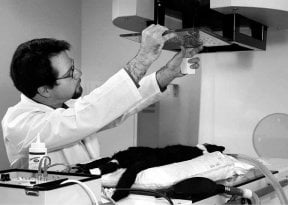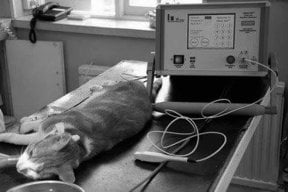The subtle signs of skin cancer in your cat can appear as innocently as a wart or a scratch. Unfortunately, these signs can go undetected until the late stages of the disease. The signs of squamous cell carcinoma (SCC) can be difficult to recognize in cats, as this common form of skin cancer can appear as innocuous as a minor scratch or wart. Oral squamous cell carcinoma, which is common in older cats, is another form of skin cancer, the signs for which are often mistaken for dental disease.
Most cases of SCC are one of two types, Oral and Solar-induced.
Oral SCC
Oral SCC occurs in and around the mouth. The most common malignant oral tumor in cats, the oral cavity tumor, accounts for only three percent of feline cancers, but nearly 75% are of the squamous cell type. Although oral SCC has been diagnosed in younger cats, the average age for most cats diagnosed with this cancer is 12 years old. Oral SCC can occur in any breed.
Cats with oral SCC can have ulcerated lesions in or around the mouth with symptoms that may include loss of appetite, weight loss, bad breath, drooling and frequent chewing motions. Cheryl Balkman, DVM, ACVIM is a Senior Lecturer and Chief of Oncology at Cornell University College of Veterinary Medicine. “Owners need to be vigilant in monitoring their pets for any changes that could be early signs of cancer and partner with their veterinarian in examining their pets,” says Dr. Balkman. Oral SCC is ordinarily very aggressive in cats. “The key…is an oral exam on a regular basis to identify a tumor…early…It still requires aggressive therapy, but surgery is more likely to be successful.”
Solar-induced SCC
Solar-induced SCC is a skin cancer that develops due to sun exposure. In general, skin tumors are the second most common type of cancer diagnosed in felines at Cornell University Hospital for Animals. Lymphoma is the most common type diagnosed. Cats with thin, light-colored hair are at greatest risk. The most susceptible cats are the white-colored ones with blue eyes. The rate of disease development, which mostly occurs in older cats, is contingent on the level of exposure to sunlight and the lack of pigmentation. Solar-induced SCC of the skin in cats is common in areas of the country where the sun shines most days. Outdoor cats are most at risk, although sunbathing in a window can increase the risk due to the elevated exposure to dangerous rays.
The cancer usually develops on the ears, face, eyelids, bridge of the nose and sometimes toes, although it can occur anywhere on the body. The lesions appear as ulcers (with or without scabs) or as nodules with a rough surface similar to a wart. Ordinarily these kinds of lesions grow slowly. Early detection of solar-induced carcinomas is vital because a range of treatment options is available early on. “The problem is that early lesions can look like a simple scratch or scab that may even heal before the lesion again declares itself,” says Dr. Balkman.
The exceptional ability of cats to hide signs of serious disease complicates the identification process. That is why these tumors are often diagnosed in their advanced stages.
Extensive Diagnosis
The initial step in diagnosis is typically a biopsy preceded by a work-up procedure that includes routine blood work prior to sedation. A veterinarian administers the amount of anesthesia needed to obtain an adequate enough biopsy to confirm the presence and degree of invasiveness of SCC. Lymph node biopsies can also be performed to determine if the tumor has spread. Additionally, x-rays and computed tomography (CT) scans can provide more information. The initial diagnostic workup can cost from $1200 to $1500. The biopsy can cost between $250 and $500.
Treatment
Surgery, radiation and chemotherapy have been the mainstays of cancer treatment. Radiation and chemotherapy however, destroy both normal healthy cells and cancer cells. This is where more targeted treatments can be beneficial. Standard chemotherapy destroys rapidly dividing cells that include both normal and cancerous cells. In one type of targeted treatment, drugs are utilized that block the growth and spread of cancer by interfering with specific molecules expressed by the cancer cells.
According to Dr. Balkman, toceranib phosphate (Palladia) is a targeted anti-cancer drug being investigated for use in cats. Palladia is a small molecule inhibitor approved for use in dogs with mast cell tumors that has shown to be effective with other types of tumors. The drug targets a number of molecules involved in cancer cell growth and survival by disrupting molecular signaling pathways that in turn stop the cells from growing and lead to death of the cancer cell. Although more studies are needed to determine the drug’s efficacy in cats with SCC, the preliminary data on the use of toceranib phosphate in cats shows it is well tolerated and safe.
Oral tumor surgery requiring partial jaw removal can cost between $2500 and $3500, contingent on the size of the tumor and duration of the surgery. Radiation therapy is also commonly used in the treatment of oral squamous cell carcinoma either separately or in conjunction with surgery. When oral tumors become invasive, however, surgery alone is rarely successful, with treatment also including radiation therapy and chemotherapy.
The recurrence of these oral tumors is quite common with the one-year survival rate of cats with oral SCC being less than 10 percent. The prognosis is more favorable if the tumor is identified early and treatment is intensive.
Surgical removal of the tumor and the surrounding tissue is also the treatment of choice for cats with solar-induced SCC of the skin. In addition to radiation therapy, cryosurgery (freezes the tumor) may also be used. In some cases, chemotherapeutic drugs are even injected directly into the lesion.
Advances in new research and targeted therapies have the potential to improve lives and provide better outcomes for cats stricken with these cancers. Balkman says, “As in the human field, the direction of veterinary oncology is toward more targeted therapies. Understanding the molecular basis of a tumor can help in identifying targeted therapeutics to treat cancer.”
Targeting Tumors
Dr. Balkman also reports that the installation of newer equipment in a number of veterinary radiation/stereotactic radiation facilities has improved the targeting of tumors while reducing the dose to normal surrounding tissues. The reduction in side effects to normal tissue increase the degree to which treatment is tolerated and quality of life is improved.
Intensity-modulated radiation therapy delivers precise radiation doses to a malignant tumor or specific areas within it from a range and variety of different angles. The intensity of the radiation varies at each of these angles and the shape of the beam is changed to match the actual shape of the tumor.
Stereotactic radiation utilizes 3-D imaging to target high doses of radiation to the affected area while minimizing the impact on surrounding healthy tissue. As the DNA of the targeted cells is damaged by the radiation, they lose their ability to reproduce causing the tumors to shrink.
Although no magic bullet has emerged in the treatment of SCC despite recent efforts of researchers in exploring the efficacy of many drugs, Dr. Balkman offers hope. “It is vital for owners to know that they still have options. Even if there isn’t a definitive treatment available, there are ways we have to make the patient more comfortable.”
This story was adapted from an article in the October 2016 issue of Cat Watch Newsletter titled “Easily Missed Signs of Skin Cancer in Cats.”




